That ol' early-century magic...
 I was a weird kid. I remember walking to Mac's Milk with my grandmother once, sometime around 1981; she was dressed like a normal person in a skirt and blouse while I sported a dramatic cape-like coat from her old tickle trunk, a purple plaid jumper-dress, white knee socks, and wine-coloured penny loafers. With pennies inserted, of course. And I insisted on walking arm-in-arm with her the entire half-kilometre or so to the store.
I was a weird kid. I remember walking to Mac's Milk with my grandmother once, sometime around 1981; she was dressed like a normal person in a skirt and blouse while I sported a dramatic cape-like coat from her old tickle trunk, a purple plaid jumper-dress, white knee socks, and wine-coloured penny loafers. With pennies inserted, of course. And I insisted on walking arm-in-arm with her the entire half-kilometre or so to the store. It was an overcast autumn day, and I felt--as I always have--that the veil between past and present is very thin for some of us. Cue creepy windchimes.
Seriously, though, somehow wearing her 1930s clothing (a feat only possible when I was 9--the last year before I got too tall and gawky to fit into nearly anything belonging to my teeny grandmother), walking with her arm-in-arm, I was pushing myself through that veil and touching the past. How can a 9-year-old have such nostalgia for bygone days? Maybe it's an argument for reincarnation.
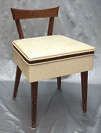 My appreciation for mid-century design and decor (1950s and 60s) is fairly recent and fed largely by my obsession with movies from that era.Check out this cool bakelite box and sewing chair (you store your sewing notions in the seat--so nuclear-age cool).
My appreciation for mid-century design and decor (1950s and 60s) is fairly recent and fed largely by my obsession with movies from that era.Check out this cool bakelite box and sewing chair (you store your sewing notions in the seat--so nuclear-age cool).
Before I fully appreciated the charms of mid-century modernism, my fixation remained squarely focused on Art Nouveau from the oughts and noughts, Art Deco and modernist styles from the 20s, and the exciting material innovations of the 30s.
Everything about that part of the 20th century is exciting. Designers and artists were pushing every envelope they could find, and then making new envelopes just to have something more to push. For the West, the world became an entirely different planet from what it had been only a few years earlier.
Consider the impact of innovators like Coco Chanel. In one decade, she helped eliminate the boned corset—a wardrobe staple for centuries--and change the face of feminine beauty. Early photos of
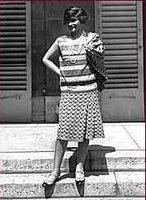 But as the years progress, we see her distinctive style take hold:
But as the years progress, we see her distinctive style take hold:
Step 1: eliminate frippery, like ridiculous hats and hairstyles that could nest entire flocks of birds.
Step 2: eliminate impractical fabrics and replace with the tried-and-true jerseys and wools used by French fishermen and Scottish hunters.
Step 3: why the heck should our bodies be so restricted? Get rid of the voluminous floor-length skirts, corsets, pinched waists, and throttling necklines.
Step 4: cut off all that damn hair, flapper style.
Step 5: make things beautiful, with astonishing craftswomanship, but without non-functioning embellishments; every button and pocket should serve some real purpose.
Chanel wasn’t entirely unique in this way—she caught and fed the larger aesthetic fever of her era. But as one of the most dogged modernists, and a woman, she’s an icon and an emblem. The same philosophies of trying new shapes, balancing beauty and function, and setting things free applied to art, literature, drama, and décor as well as fashion. What could be more exciting? Can you imagine what it was like to be part of it?
…In this post are a few choice items of this era I’ve found from online antique décor purveyors JZ-Rose.com, Tomgibbsstudio.com, and others. Enjoy some of the best from the early 20th century: one of the places I’ve always felt most at home.
(P.S. The brooch at the top of this post is Art Nouveau, circa 1900, yours from J-Z Rose for the small price of $35,000.00, plus tax and shipping. Isn't it the most gorgeous thing ever?)
Art Nouveau--New Art for a New Century
Early 20th century Lamartine vase--stunning. Click for more detail.
This exceptional etched glass and wrought iron Daum lamp--yes, lamp--is like nothing I've ever seen before. Very 'War of the Worlds Stops In for Tea.' JZ Rose.
This glorious Art Nouveau chair showcases the experimentation that was going on in household design.
Screens were big in the early part of the century. Screens are big now, too, but now we're talking LCD and then we were talking Morris and Co., Lamartine, and others. Arts and Crafts designs, and Art Nouveau beauties like this azure lovely to our left, renewed the obsession of the craftsman and drove cool innovations like the curvy butterfliety of this screen. I vote for the re-emergence of the screen. So handy for hanging your silky nothings upon...
Art Deco--
Lalique Art Deco glasswear, like this glorious mirror and the clock beneath it, came out of
Galle was another Art Deco glass artisan. This is one of his lovely
perfume bottles.
The 30s: Doing More With Less
Post-Depression artisans were forced to look for less expensive materials with which to produce their wares. Mass production became popular. From what I can tell, it was all about boys and their toys. Housewares became strong and handsome as the impact of WWI and the big stock market crash hardened us a little. And I'm sure socialism and communism and the rise of despots like Hitler played a role there too, but that's just a guess. Steel became popular--as we see with this manly steel clock.
But that's not to say femininity disappeared altogether. In Hollywood, Garbo and Dietrich and Davis and the gang made all women want to be gorgeous and glamourous. And of course, the French never lost their glamour in the first place--not even during the ravages of war. These dreamy, ubergirly French chairs prove it.




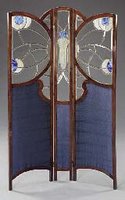
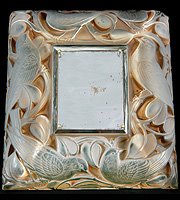



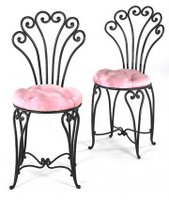

1 Comments:
is it wrong to love this stuff more than, oh, people and uh my career or whatever other totally unimportant non-beautiful things i have in my life that don't look this this? seriously, i gasped and felt a little woozy when i saw the brooch, and the chairs made me giggle and the vase made me wistful and the lamp made me...well, the lamp's a little weird, but i'd still love to have it in my over stuffed living room...
Post a Comment
Subscribe to Post Comments [Atom]
<< Home